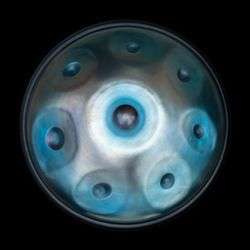Handpan

Handpan is a term for a group of musical instruments resulting from a growing worldwide interest in the Hang, an instrument invented and built by the company PANArt Hangbau AG.
Properties adopted from the Hang by most handpans are the basic form consisting of two metal half-shells glued together, a center tone field surrounded by a circle of at least seven tone fields on the upper side and an opening in the bottom side. Differences as compared to the Hang are the used materials, the manufacturing processes of the raw forms, the shaping of the tone fields and the tuning methods. Some handpans are also different from the basic tone field layout of the Hang.
History
The term handpan first appeared online in the fall of 2007 on the website of an American steelpan producer Pantheon Steel. It was used to describe its own development of a new instrument which was launched as an alternative to the Hang.[1]
Consequently, the term found its way into discussions in the defunct Hang-Music Forum on the Internet.[2] The successor of this forum was founded in 2009 and was called handpan.org.[3] This way the expression handpan found wide circulation. A new generic term for this group of instruments had become necessary as PANArt had registered the name Hang as trademark for musical instruments.[4]
The first five instruments, which are generally included by the term handpan, were Caisa by Kaisos Steel Drums (Germany, 2007), BElls by BEllart (Spain, 2009), Halo by Pantheon Steel (USA, 2009) Spacedrum by Metal Sounds (France, 2009) and Battiloro by Battiloro Handpan (Italy, 2013). Today, significantly more than 100 handpan builders have entered the market and offer instruments that vary widely in material, manufacturing techniques, shape, sound and quality.[5][6]
Discussion about the term
The term handpan was discussed controversially. Critics pointed out that the Hang, which all makers of handpans use as a standard model, is essentially defined through its difference from the steelpan. Furthermore, the term pan is used for the national culture of the steel bands in Trinidad and Tobago, to which neither the Hang nor the instruments called handpans bear any relationship. Supporters stressed the necessity of a generic term. They advocated that handpan is a suitable and well-understood new term for the abbreviation of a steelpan played by hand. It has become a conventionalized expression among those who are interested in these kinds of instruments. [7]
The Hang makers of PANArt, Felix Rohner and Sabina Schärer, reject the expression handpan to describe the Hang. "To state it clearly and precisely: we do not make percussion instruments, handpans or hang drums."[8]
An alternative term used by some builders and players is Pantam. It is said to be a combination of the words Pan and Ghatam, two instruments which influenced the creation of the Hang.[9] Originally this term was an alternative name for the Hang in Israel.[10]
References
- ↑ "Home page of www.pantheonsteel.com". Archived from the original on October 16, 2007. Retrieved 2013-08-17.
- ↑ "Sub-forum "New hand pan development" by the Hang-Music Forum". Archived from the original on November 12, 2007. Retrieved 2013-08-17.
- ↑ "handpan.org/forum/". handpan.org. Retrieved 2013-08-17.
- ↑ WIPO Global Brand Database. International Registration Number 969295
- ↑ "handpan.org sub-forum Meet the Family". handpan.org. Retrieved 2015-11-15.
- ↑ World Map of handpan makers
- ↑ "What is a handpan?". Discussion about the term on www.hangforum.com. Retrieved 2013-08-17.
- ↑ "Newsletter PANArt, May 19th, 2010". hangblog.org. 2010-05-19. Retrieved 2013-08-17.
- ↑ http://www.hangdrumsandhandpans.com/2013/06/what-is-pantam-answered.html
- ↑ Das Hanglexikon: Pantam